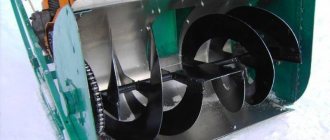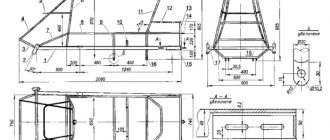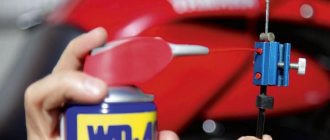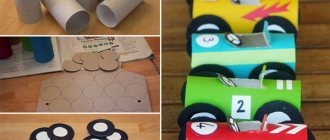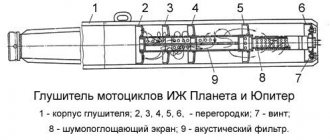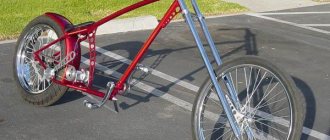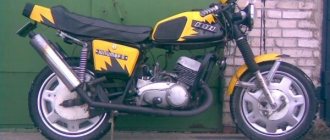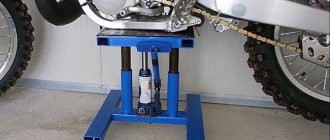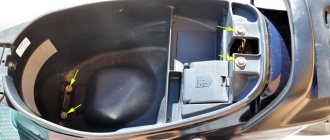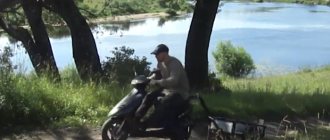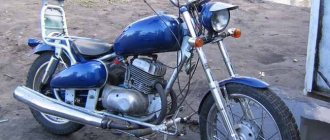It doesn't matter if it's a heavy cruiser, an enduro or a mild-mannered tourer - every meter counts in this situation! We advise you on how to brake your motorcycle safely and effectively and how to properly adjust the brake system.
Braking on a motorcycle
Citizen Kovalskaya drives carefully because she was in an accident twenty years ago. Today started out badly for her - her neighbors flooded her apartment early in the morning! Moreover, her child was unbearable in the morning, and his guardian was more than a quarter of an hour late! As a result, a crazy and furious Kowalskaya gets into the car and rushes to work. As she leaves the main street, she looks left and right out of the corner of her eye. And he doesn’t notice the oncoming motorcyclist...
If you are a motorcyclist, then prayer is not enough. You only have a few seconds to avoid a collision with a car that suddenly appears in your way. In a split second, you must make a decision - stop or try to avoid a collision.
What is the reason for emergency braking? We will explain this using the example of the Honda 1000 CBF. To show all stages of braking as accurately as possible, all changes and even the slightest errors, we equipped Honda with a set of electronic sensors and a data recording system. We measured everything from the hydraulic pressure in the brake systems, through the suspension movements, to the skidding of the front wheel and thus recognizing the tendency of the wheels to lock.
Braking on a motorcycle
Braking from hundreds of km/h to zero
The first attempt is hard braking at a speed of 100 km/h without ABS. The test is carried out on an airport runway, where bollards lay out the stopping distance. 100 km/h on the speedometer and braking begins. The stop is accompanied by an elegant stop, and a distance of 40 meters is sufficient. This means that the average delay is 9.8 m/s2. This is the stopping distance, but if you brake or lose attention while braking from 100 km/h, you will cover 28 m (!) during this time. Thus, the total braking distance consists of the driver's reaction time and the time when the appropriate pressure is created in the brake system and the load on the wheel changes dynamically.
Dynamically changing the load on a wheel sounds like a physics lesson. What's happening? In a motorcycle, due to mass inertia and the height of the center of gravity, an increase in delay causes loads to move between the wheels. The load at the front increases and the load at the rear decreases proportionally. As the load on the front wheel increases, it can carry more braking power. The higher the load, the greater the pressure. Its size depends on the total weight of the rider and motorcycle and is transmitted to the tire through spring resistance and partly through damping resistance.
Thus, the dynamic load on the wheels changes. The effectiveness of emergency braking depends on this. To do this, it is necessary to continuously change the pressure in the brake system for 0.5-0.7 s (depending on the position of the center of gravity and wheelbase) along with the deflection of the fork.
If you do this quickly (in less than 0.1 second) and apply too much force to the brake lever, you will likely have problems. This is because the front wheel can only transmit load-dependent braking force. If the braking force is too great in relation to the load, the front wheel will slip and may even lock up, rendering the motorcycle unable to ride smoothly. And that's the likelihood that you will slip and fall. Therefore, at the beginning of each braking, avoid nervous and sudden movements - ideally, after 0.5 s you will increase the pressure in the brake system to the maximum possible.
Braking on a motorcycle
About the effectiveness of the front and rear brakes
On asphalt, always and in all cases, the main brake is the front one. It is the most effective both structurally and from a physical point of view. When you start to brake, the motorcycle seems to “nod off”. The front wheel is loading. Its contact area with asphalt increases. While the rear one may even come off the surface (stoppie), and then there will be no braking at all.
This does not mean that the rear brake is not effective and should not be used. By refusing it, you lose up to 50% of your braking force. Two brakes will always be more effective than one!
Difficult task
The second topic in emergency braking is the optimal use of both brakes, i.e. Maximum use of rubber and asphalt grip. This is a very difficult task - not everyone can brake the front and rear so precisely to fit in the narrow range between sliding and turning. For this reason, motorcyclists usually focus on the optimal dosage of the front brake.
At this point, racers and racer fans are learning that in racing motorcycles you can forget about the rear brake. Yes, but driving every day is something completely different from the track, because braking to an intersection with a delay of 9 m/s2 is like wishful thinking. Even experienced motorcyclists do not experience a delay of more than 7 m/s2 when entering narrow intersections. From this we conclude that as long as the rear wheel is not torn off the ground, it can be braked. Whether this point is reached, and whether it is, depends primarily on the type of motorcycle (more specifically, the position of its center of gravity, wheelbase, tires, etc.) and the delay.
Sports bikes that have more load on the front wheels used to lift the rear wheels, like our test Honda CBF 1000. It locks the front wheel first and then lifts the rear. Therefore, it is very important that the rider knows exactly the specifics of the motorcycle he is riding. For example, you should feel the dosage of the brakes. But other factors also matter. If, for example, on uneven pavement the fork hits faster than the rider expects, the wheel will temporarily lose contact with the ground and traction.
It may also happen that the motorcycle - without warning - will show the desire to do a somersault over the front. Both phenomena require an immediate reaction, and after its elimination, restoration of pressure in the brake system. Such operations are only successful if all drive and brake components match. This is why the correct distance between the lever and the handlebars, as well as the accuracy of all system components, are so important.
Our second attempt is emergency braking at a speed of 200 km/h. This challenge is a sure-fire way to increase your heart rate. Unlike the first attempt (braking from 100 km/h), when you can hear the tires squealing, when braking at a speed of 200 km/h, the squeal dampens the wind noise. A locked front wheel is the only and final warning signal. This forces you to be extremely careful. This can be seen after a relatively slow increase in brake pressure and after a fairly moderate deceleration of 9.3 m/s2 (braking distance 166 m). Only after several attempts does one of the riders achieve 9.7 m/s2 (braking distance 159 m).
Braking on a motorcycle
Full control.
Contents of the material
- Full control.
- Chapter 1. Traction
- Chapter 2. Taxiing
- Chapter 3. Suspension
- Chapter 4. Fear
- Chapter 5. Concentration
- Chapter 6. Right Attitude
- Chapter 7. Vision
- Chapter 8. Trajectory
- Chapter 9. Gas
- Chapter 10. Shifting gears
- Chapter 11. Brakes
- Chapter 12. Body position
- Chapter 13. Turning at Low Speed
- Chapter 14. Riding with a passenger
- Chapter 15. Setting up suspensions
- Chapter 16. Ergonomics
- Chapter 17. Aerodynamics
- Chapter 18: Chassis Setup
- Chapter 19. Fitness
- Chapter 20. Equipment
- Chapter 21. Track training
- All pages
Page 1 of 22
Effective Street Driving Techniques
LEE PARKS "FULL CONTROL"
PREFACE
It so happened that most of the forty years of my life were connected with motorcycles. Since childhood, I dreamed of riding a bike, and I sat on the saddle when I turned eleven. Since then, my hobby has captivated me more and more, I even wrote a book, “The Complete Idiot’s Guide to Motorcycles.” And recently I realized one interesting thing - I almost don’t know how to drive a motorcycle. Quite a strange discovery for a person with my experience, isn’t it?
For a long time I was into motorcycle touring, I was one of those guys who ride 1000 miles a day. My ultimate dream was to win the Iron Butt Rally. The sportiest bike I owned was the Honda ST 1000. A few years ago, everything changed overnight when I joined the Speedvision channel (now called the Speed Channel). From that moment on, the world of motorcycle racing ceased to be something that Cycle World wrote about months late in the back pages. Cable TV brought the racing straight to my living room, live.
But Speedvision was only the first step down a slippery slope. After a while I started hanging out with bad guys. Not with those who wheelie around the streets in strange clothes at hundreds of miles per hour, but with real athletes who have racing licenses and compete in national championships. With a few exceptions, they were all sensible people who had mastered racing skills to perfection. To become a full member of the group, I had to greatly raise my own level.
There is nothing unusual in my story. Every year more and more motorcyclists try to reach new heights. Unfortunately, in most cases, their efforts come down to buying the latest model of sports motorcycle. For some reason they believe that the key to success lies in technology. And so they rush to the store to buy exactly the same motorcycle as the winner of Sunday's race. Then they put pendants on it from companies whose names are written with umlauts. Then they tune the engine, although the factory power is too much for them. Of course, good technique allows you to achieve more, but only if the rider has the necessary skills. Tuning without skills is money down the drain.
I was lucky - I couldn't afford expensive bells and whistles, so I had to focus on skills. I put my pride aside and started asking questions to the guys in the group, not worrying about how stupid I looked in their eyes. I eagerly absorbed their advice, and then got on my motorcycle and trained for hours.
After some time, I began to look for a racing school to train with an instructor. Everyone recommended Advanced Riding Clinic to me. Having contacted this school, I was surprised to find that the cadets were being trained by my old friend Lee Parks.
It should be noted that by that time I was working as an editor at the publishing house Motorbook International. My responsibilities included searching for topics for future books and finding authors to write them. And then such luck - Lee teaches at a racing school, Lee is an experienced and talented author, therefore, he simply has to write a book. Which is what he did. True, due to Lee’s busy schedule and his inherent meticulous attention to detail, the work took a lot of time, but the result exceeded my wildest expectations.
Within these pages you will find the key to the treasures of Lee's many years of experience. With this book you can become faster and drive safer. When I first saw Colin Edwards or Nicky Hayden run the course, I decided that they were doing something impossible, inaccessible to us mere mortals. This book will show you how to do the same. Of course, after reading it, you will not instantly turn into Valentino Rossi, but you will be able to master his techniques. Lee Parks breaks down each technique into a sequence of simple steps and explains how to perform them. At one time I was amazed
how much this approach raised my own level. And although my bike (Yamaha YZF600R) cannot be called the best sportbike of our day, I am increasingly ahead on the track of those who used to show me the rear tire. I hope this book helps you as much as it helped me.
Take care, Darwin Holmstrom
ACKNOWLEDGMENTS
At first, I decided that I could handle writing the book in no time. I will simply outline in writing the course of my school, Advanced Riding Clinic (ARC), which I know like the back of my hand. How wrong I was! Fortunately, fate gave me great friends and an amazing family; without their support, the book simply would not have happened.
First of all, I want to thank my editor, Darwin Hallstrom. Not only did he give me the idea for this book, but he kicked me every day until I completed it. Without him, the book would have remained a dream.
I would like to thank Paul Teed, founder of Race Tech, who allowed me to use his articles for the suspension chapters. I could never write like that.
I want to thank everyone who shared their time, abilities and knowledge with me. This is science editor Ray Engelhardt, who managed to explain physical laws to me without involving abstruse formulas. I still wonder how he managed it. These are ARC instructors Tracy Martin and Ed Perlsell, who not only filled in for me at school while I wrote the book, but also served as models for many of the photographs. Kent Larson, NESBA, helped me with Chapter 21 on Track Training. Tom Riles taught me how to take photographs. Terry
McGarry, L.T. Schneider, D. C. Wilson, Ken Marena, Jason Elzordia, Peter Tavernis, Priscilla Wong, Debbie Webber, Amy Holland, Kevin Cameron, Kevin Wing, Andy Goldfine, Mansoor Shafi, Denis Sullivan, Randy Hatch, Kent Soigner, Michael Martinucci, Kim Andersen - all helped to me on many occasions. And special thanks to the guys from Avon who provided the photos.
Thanks to my parents who gave me the opportunity to engage in motorsports. My father taught me to ride a bike and encouraged my hobby in every possible way. He also got me my first job, where I learned how to write, edit and layout articles, and taught me my first photography lessons. Mom spent a bunch of weekends taking me and my friends to the motocross track. Then she patiently read novels while our engines roared nearby and kicked up clouds of dust. She also taught me how to teach.
My students' contributions to this book cannot be overstated. They learned from me, and I learned from them, honing my skills during classes.
Although most of the ideas in this book are the result of my personal experience, they are all based on methods developed long before my time. In February 1676, Sir Isaac Newton wrote to his colleague Robert Hook: “I can see further because I stand on the shoulders of giants.” I want to thank my giants - Keith Code, David Huff and Freddie Spencer. In many cases I quote them verbatim, but anyone who has read their work will easily recognize their influence on every word in this book. It is difficult to overestimate their influence on me and my methods.
Finally, I would like to express my gratitude to Landmark Education (www.landmarkeducation.com) and Curriculum for Living. My career would not have happened without them.
I have a terrible memory, so I apologize in advance to anyone I forgot to mention. All my life people have helped me and one page of text simply cannot accommodate everyone. This book can be dedicated to the generosity of people. Thank you everybody.
INTRODUCTION
The speed and capabilities of modern motorcycles have increased greatly in recent years. A stock sportbike is almost no different from its racing brother. Modern technology places very stringent demands on the driver, which means that driving training must reach a higher level.
Why is it difficult to learn to drive fast?
I spent a lot of time in motorcycle schools both as an instructor and as a student. I am absolutely convinced of the benefits of such schools. The knowledge I learned from motorcycle school saved my life several times. For a person who wants to learn how to corner quickly, there are two options. He can enroll in the Motorcycle Safety Foundation Experienced Rider Course or apply to one of the racing schools. Each option has its pros and cons.
The problem with MSF ERC is that training is carried out at low speeds. The courses are very helpful and I highly recommend everyone take them, but they will not teach you how to deal with speed anxiety. Racing schools, on the contrary, offer to perform exercises at too high speeds, unusual for the average motorcyclist. Therefore, during training, cadets are simply afraid to learn new techniques. A racing school is ideal for those who want to improve their existing high-speed driving skills.
I was an editor at Motorcycle Consumer News from 1995-2000, so I was fortunate to work with David Huff and Keith Code on many riding articles. They piqued my interest in the topic and I realized that I still had a lot to learn. Despite the fact that I took second place in the AMA championship in 1994 in the GP125 class, I drove on a whim, I lacked knowledge. I was fast, but unstable. If I found myself on an unfamiliar track and didn't get into it right away, I couldn't even realize my mistakes, let alone correct them. My long association with Huff and Code helped me understand the theory of driving, the physics of the process, so to speak, and I learned to recognize my problems and find ways to solve them.
A new way of learning
Many MCN readers have complained that there is too much of a gap between the MSF ERC and the racing schools. They would like to find something in between; many did not even want to go to the track, despite the propaganda,
which I unfolded on the pages of the magazine. All they needed was “a little cooler than the MSF ERC.” In addition, many readers have noted with regret that all books on motorcycle riding are written by racers for racers, and are too difficult for ordinary motorcyclists. They want simple solutions, not sophisticated racing strategies.
After listening to all this, I decided to open a new type of racing school. The idea was to combine the techniques of racing schools with the relaxed atmosphere of an empty parking lot where MSF ERC classes take place. In addition, I planned to break each technique into several simple actions, learn them separately and only then combine them.
Using my friends as guinea pigs, I created a training program and developed exercises. The basis of the training was a simple idea. There is no need to force a person to learn techniques all at once at high speeds, say 20 miles per hour faster than he is used to driving. It's better to ask him to go 2 miles per hour faster, then he won't get scared.
For example, a racer can spin a 4-foot circle at 32 mph. The average driver can do the same thing at 17 mph. If a person feels comfortable, he is happy to learn something new. So to start, I ask the cadets to do the drill at 0 mph. One of them sits on the motorcycle, the others tilt the motorcycle to the desired angle. Meanwhile, I point out to the cadet his mistakes and form the correct landing. We repeat this exercise several times until the cadet begins to do everything correctly on the spot. Then he goes around the circle and circles it at 17 miles per hour, trying to do it right. Then he increases the speed to 19 miles per hour, then to 21. Let's say at 21 miles per hour he starts having problems. I come to the rescue and make sure that he calmly passes the circle at this speed. After that it accelerates to 23 and so on. He may not be able to do this drill at 32 miles per hour, but by the end of the training he will certainly improve his skills greatly. This technique formed the basis of the Advanced Riding Clinic.
The effectiveness of this approach has been proven on hundreds of cadets. Even though it was designed for casual motorcyclists, even some professional riders have found it useful.
I actually stumbled upon this method when I was in college. There was a huge parking lot next to our dorm that was only used during sports events. One day, when there were no competitions, I rented the whole thing, threw a couple of old T-shirts on the asphalt and began to practice hanging. I didn’t arrange a complex trajectory for myself with a lot of turns and braking, because I intuitively believed that the simpler the better. And so, dressed in full protection, I went out onto the “track”.
I spent five minutes moving the bike from right to left and back again to warm up the tires (like the real racers I saw on TV), then began to increase the speed little by little. I found that I had to change my body position to cope with the increased speed. I didn't have an instructor to tell me if I was doing everything right, but still, gradually increasing my speed, I finally touched my knee to the ground. I felt like I had started a new life.
Instead of training further, I parked the bike, collected my jerseys and returned to the room. I felt like a new person. Every motorcyclist remembers the day he first touched the ground with his knee in a turn like it was yesterday. As a rule, he achieves this after many months of training. I achieved this in thirty minutes in an empty parking lot, feeling completely comfortable. You can do the same. In addition, you have this book, which can replace the instructor who was absent from me at that time.
Creating a book
I traveled around the country with the school's program and discovered two things. Firstly, all my cadets made great progress in their classes. Secondly, I covered a negligible portion of motorcyclists.
Knowing that, despite my best efforts, I could not teach everyone, I stopped advertising the school.
But is it possible to hide something in the Internet era? Happy school graduates posted their messages on all possible motor resources. Darwin Holmstrom, editor of Motorbook International, noticed them and asked me to write a book on the school's curriculum. I thought about it myself, but Darwin's suggestion made the idea a project. In the end, the book is the only way to convey the school program to all motorcyclists, so I sat down at the computer.
To retest my ideas and methods, I decided to return to professional racing. Out of a huge selection of competitions, I chose the WERA National Endurance Series because multi-hour races provide more testing opportunities. I joined the Speed Werks/Cyberlogtech team racing the Suzuki SV650. The team's other two drivers have just received their super licenses after a year of racing in the rookie class. I didn't want to fight for the championship, I just wanted to try my training program again.
To our surprise, the rookie team won the championship. Obviously, the training program was quite suitable for publication.
Our team owner, Scott Gowland, was killed two weeks before winning the championship. His contribution to success can hardly be overestimated. This book is dedicated to the memory of this remarkable man.
What is this book about?
The purpose of the book is to teach you complete control over the bike. As California Superbike School senior instructor Coby Fair aptly puts it, “total control” means making the bike be in the right place at the right time. You will determine the purpose of such control yourself - whether to drive more safely at your usual speed, or to increase the speed at the same level of safety.
This book reveals the secrets of motorcycle control; there is not a word about racing strategies. Not only will it help you improve your skill level, but it will also teach you how to recognize weaknesses in your skills. There are no general tips like “be smooth” or “be fast.” Keith Code once called such advice "clueless" because it doesn't explain how to achieve it. By doing the exercises in this book over and over again, sooner or later you will begin to perform them correctly, that is, smoothly and quickly.
How to use the book
The book is divided into six parts, you need to read them in order (I don’t like postmodernism, you know). The first part is devoted to the physics of the chassis. I had to try to explain all this without involving mathematical apparatus. Understanding physical principles is essential to conscious training, so I highly recommend not skipping this chapter.
The second part describes the psychological aspects of driving. Knowing how your brain perceives reality is very important; without it, you simply won’t be able to drive effectively.
The third part explains as clearly and in detail how to master the necessary skills. The illustrations show not only the correct execution of a particular technique, but also possible errors. In classes at ARC, I also demonstrate not only correct, but also incorrect execution of techniques. I've also included training outlines in the chapter so you can follow the exact same course as in ARC.
A standard site measures approximately 70 by 100 meters. The coating must be smooth, dry, free from dust and puddles of oil. This can be found in a large parking lot. The diagrams show the route markings and diagrams of gas and brake use. Don't forget before your workout
warm up the tires to operating temperature, shift the motorcycle from side to side. Believe me, your time on this will not be wasted.
It is very useful to train with a friend. It's best if he reads the book first too, but if not, just show him the workout diagram and pictures of correct and incorrect exercises. A comrade should evaluate your actions, because from the outside you always know better. I also recommend recording your workout on video. Trust my experience, this greatly speeds up the development of techniques.
Part 4 covers the intricacies of tuning your bike for high-performance riding. Each chapter is useful, but Chapter 15, which covers suspension adjustments, should be read before you begin training.
The fifth part is devoted to preparing the rider for high-performance driving. The gear chapter is based on hundreds of studies conducted during my time at Motorcycle Consumer News, as well as my 20 years of racing experience.
The Right Attitude
The techniques and methods outlined in this book have proven their effectiveness in practice. But other points of view on driving a motorcycle also have a right to exist. For example, Larry Pegram, whom I mercilessly criticize in some chapters, is a much faster racer than I am. My point is that the more techniques you try, the sooner you will find the one that suits you best.
I encourage you to try on techniques the same way you try on jackets in a store. You don't have to buy a jacket you try on, but the more jackets you try on, the sooner you'll find one that fits just right. The right approach to training is not to master everything, but to master the techniques you need today. I assure you, it is simply impossible to master everything at once. Later, when you want more, you can return to the book and level up.
This book is like a cookbook. Take it off the shelf when you need the next recipe. Fold the pages, leave notes in the margins, because the more useful the book, the more shabby it looks. Get another copy for your motorcycle friends and put it on the coffee table.
And don't forget, training should be fun. My mantra is: “Life is better with a motorcycle.” Robert Pirsig, in his wonderful book Zen and the Art of Motorcycle Maintenance, said it even better: “The only motorcycle you should be working on is you.” Practice techniques not only to drive faster and safer, but also to make your life more fulfilling and creative. Feel free to tailor the recommendations to suit yourself, because even the simplest steps performed by a talented dancer bear the imprint of his personality. The more fully you express yourself, the happier your life, so practice to make your life better.
- > >>
The first attempt must be successful
When a truck traveling in the opposite direction suddenly prevents you from overtaking, there is no time to think. The first try must be successful, because if not, then... ABS is here to help you! At full speed and with the brakes pressed all the way, the Honda CBF 1000 develops a speed of 9.5 m/s2 (braking distance 162.5 m). Because braking distance increases with the square of speed, the Honda CBF 1000 does not require double the 100 km/h (40 m) braking distance, but a full 122 m more.
Our test #3 is to detect differences in braking performance based on different friction coefficients. So it's about checking what braking feels like when driving on a slippery asphalt section or, for example, broken gravel on a road. This situation is extremely challenging. Hard braking at a speed of 100 km/h after a 20-meter remission, only to be erased again after 3 meters of gravel - this is the task we set for the test riders.
After slipping on the first try, the driver releases the brakes 14m, about 11m further than necessary. As a result, the braking distance increases to 48.7 m. What does ABS do? Just a few meters past a patch of gravel where the wheels briefly slide, the brake is applied so that the rear wheel is momentarily lifted off the ground. Honda stops after 45 m.
Emergency braking - how to do it correctly?
A motorcycle that is not fully operational means a crash in the event of emergency braking. Since every sudden braking causes enormous costs and moments, it is necessary to optimally transmit and distribute the force of the hand and foot. Very high friction forces occur on the brake lever, in the bearings. When the bearings are not lubricated, under high loads, static friction does not allow accurate pressure dosing. For this reason, the pin and its friction surface in the brake pump must be lubricated with pressure-resistant lubricants or copper paste. Only through this can you cope with the great forces that are happening here.
The brake lever (if adjustable) should be set so that the fingers extended over the lever and forearm form a more or less straight line. This can be done after loosening the clamping screws. When installing the asymmetrical steering wheel pump clamp, be sure to first tighten the bolt marked with the arrow and the word "up" until there is no gap between the parts. Only then is the pump attached to the steering wheel with the bottom bolt. When pumps are installed incorrectly, they bend with great force - the brake acts like dough and feels soft.
The subjective impressions of the motorcyclist, which determine the correct dosage of braking, depend, first of all, on the position of the lever. Many machines have a suitable ratchet mechanism for this purpose. Adjust the lever so that the driver can operate it sensitively. To do this, you should try out all possible positions, because this is the only way you can determine the most profitable ones.
If you press the lever with your whole hand, this usually means a shorter distance, which provides a better feel for the braking process. Disc brakes on sport bikes often respond quickly with minimal pressure. This allows you to brake with only two fingers. If someone brakes this way, they should move the handle further away from the steering wheel to avoid crushing their remaining fingers.
Braking on a motorcycle
In the case of a rear brake, complex adjustment of the foot from under or to the side of the lever costs time and interferes with metering. Therefore, install the pedal so that your foot rests freely on it.
In the event of a sharp turn while downshifting, the rear wheel must be taken into account. This is especially true for high power and braking torque engines. The remedy for this condition in modern motorcycles is called an anti-hop clutch. If the motorcycle does not have it, then it is enough to release the clutch after reducing the gear. This allows you to maintain the engine braking effect, but reduces the maximum braking force that occurs at the moment of compression and prevents wheel rebound.
IN TURNINGS
A very important warning: before entering a turn, you should complete the braking - this is an axiom. If the turn is smooth, then most often it’s enough just to let off the gas - the scooter will slow down a little. Although the CVT does not transfer braking force from the engine to the wheel when the throttle is closed, there is still some resistance in the transmission, plus the scooter's rolling resistance and aerodynamic drag will slow it down.
When entering a turn, mentally outline the trajectory of movement - a smooth curve with a maximum radius. If the speed is exceeded and, as a result, the scooter is tilted excessively, the grip of the tires will not be enough to hold the car - and a fall will occur. So, cornering at a moderate speed along the maximum radius will allow you to tilt the body less, which means that the grip of the tires on the road will remain quite high.
The most common position of the body relative to the scooter is when the tilt of the body is equal to the tilt of the machine. Other options: when the body tilt is greater or less than the scooter's tilt angle.
The first method is classic, this is how most scooter and motorcyclist riders ride, and this alone says that it is best suited for normal conditions.
Tilt of the body at an angle less than the tilt of the scooter allows you to make a turn along a minimum radius. The method is used for fast maneuvering at low speed.
The “body tilted more than the scooter” option is rarely used. In this case, the reserve of tire grip on the surface is far from exhausted (thanks to the special profile, tread pattern and tire composition), and it is impossible to tilt the vehicle to a greater angle. In addition to the body, the leg bent at the knee is extended to the side (this style is called “turning with the knee”). And sometimes the driver moves from the seat cushion to the inside of the turn. The technique is used for sports driving, but not on public roads.
The specificity of scooters with a CVT transmission affects maneuvering at low speeds. When the driver releases the gas, the scooter continues to move by inertia. When leaning towards the turn, the center of gravity moves towards the inside of the turn. In this case, the steering wheel turns in the same direction to compensate for the tilt. On motorcycles with a gearbox, in which the transmission provides a “rigid” connection between the wheel and the engine crankshaft, the driver slightly adds gas, which instantly causes acceleration and the appearance of centrifugal force, compensating for the overturning moment. In scooters, when the gas is increased, the V-belt variator and centrifugal clutch do not engage immediately, but with some delay. An experienced scooter driver goes through a turn without releasing, but rather accelerating. If it is necessary to reduce the speed, the brake is used, but not the throttle is released “to zero” speed: the driver must be sensitive to the device and create tension so that the transmission does not disconnect the wheel from the motor, and if necessary, the gas should be slightly increased.
20% more effective after 30 minutes
And test No. 4, the last one – complex braking. You often hear the statement that folding and braking at the same time are incompatible. It is not true! Depending on external conditions (including the temperature affected by the tires, and therefore the grip), in a Honda CBF 1000, slope 35 output a delay of 8 m/s2 can be obtained. Only an experienced rider can make such a difference under hard braking.
This type of braking should only be used when there is no other way to avoid an accident. Then even the slightest slip of the front wheel can turn into a skid. And this means his departure to the side, with all the ensuing consequences. And, in addition, the rider sometimes fights the tendency to get up from a slope.
Our series of tests allows us to conclude that without studying braking with maximum deceleration, you can’t get anywhere. As a consolation, we have the information that the secrets of this art are easy to master. Half an hour of training was enough for each of the three bikers taken from the street to reduce the braking distance to 20%. More important than their own successes, they all acknowledged that they understood how their safety depended on the laws of physics and where it ended.
How does the braking system work?
A person's power is infinite if he can only get a long enough lever and a fulcrum - this principle also applies to motorcycles. Only through mechanical and hydraulic amplification of human power is it possible to stop even the heaviest machines from maximum speed to zero.
To control heavy vehicles, the driver presses the brake lever with a force of about 120 N (this was measured between the middle and ring fingers). As a result, an average pressure of 18 bar is created in the brake system. This pressure is transmitted through the brake lines to the pistons in the clamps, which in turn push the brake pads against the rotating disc brakes.
Manual pressure and hydraulic pressure are something that has nothing to do with technology. This is different from cylinders and brake pads. The stiffest clamps are used here, which do not deform under load and temperature. Monobloc clamps, cut from a single piece of aluminum, are becoming increasingly popular and, when combined with radial clamps (a more stable connection to the fork shank), provide better braking.
Older cars and cheaper new cars have solid fixed four-piston calipers. Even the flimsy design of the floating clamp used in the Honda CBF 1000 is sufficient for effective braking.
Whether brakes are sharp or dull is determined by the mixture of materials used to make the brake pads. Metal alloys are most often found here, guaranteeing good braking performance in both cold and hot conditions. In the past, organic mixtures were used, which slid coldly over the discs, and wet ones often failed. Therefore, most manufacturers also offer modern sintered versions for older models.
By installing steel-braided high-pressure cables, acceptable results can also be obtained in older brake systems.
The tires hit the road with a coefficient of friction of 1.2 (supersports tires on a race track), allowing delays in excess of 10.0 m/s2. Real delay increases air resistance. You can add them because it is not carried by the tires. For this reason, when braking from 200 km/h, decelerations above 11 m/s2 can be achieved.
The rider controls the braking force thanks to a mechanical and hydraulic transmission. The example shows a comparison of a radial manual master cylinder (above) with a conventional pump. In the latter, the mechanical ratio is lower (1:6) than that of the radial pump (1:7.5). However, the 16mm diameter piston allows for greater hydraulic transmission. As a result, the results are balanced and the brake pressure is identical. The difference is in the best dosage of the solution with a radial pump.
Braking on a motorcycle
Post Views: 2,868
ENGINE STARTING
Starting the scooter engine is not difficult. The driver is required to turn the key to the “ON” position - the ignition will turn on. Press either brake lever and then the electric starter button to start the engine. Why do the instructions only require the engine to be started when the scooter is on the center stand? If it is on wheels, and the driver or an onlooker standing nearby inadvertently turns the throttle, the device will drive away, or at best, fall and scratch the lining.
After starting a cold engine, do not fuss; let it idle for a few minutes. This is not a ritual before the road (like “Let’s sit down, friends ...”), but a necessity: an unheated engine runs with “dips”, reacts sluggishly to gas or even stalls. While the engine is warming up, look around the dashboard to see if everything is in order: is there enough gasoline in the tank, is the red oil level light on (for two-stroke engines). If it lights up, the oil must be added immediately: there will be no second warning - the engine will seize.
If the engine does not start (which happens with older scooters), you will have to look for and eliminate the cause. You can't push start a scooter.
